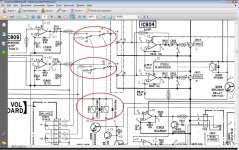Hi all,
I am the proud owner of the above components, causing a strange crackling sound at random times.
The sound is coming from the right hand side channel from BOTH units.
I verified this by checking the preamp connected to my valve amp, then the 3200 on it's own (was quieter than with the preamp connected buy a light crackle was present again in the right channel.)
Does anyone know what may have caused this to occur in the right channel of both units? I recapped both units a year ago with high quality Nichicon caps of identical spec and both units went flawlessly until recently.
The preamp outputs the noise no matter what source is selected and this is the same with the power amp, which lightly crackles constantly.
Any help would be greatly apeciated.
I am the proud owner of the above components, causing a strange crackling sound at random times.
The sound is coming from the right hand side channel from BOTH units.
I verified this by checking the preamp connected to my valve amp, then the 3200 on it's own (was quieter than with the preamp connected buy a light crackle was present again in the right channel.)
Does anyone know what may have caused this to occur in the right channel of both units? I recapped both units a year ago with high quality Nichicon caps of identical spec and both units went flawlessly until recently.
The preamp outputs the noise no matter what source is selected and this is the same with the power amp, which lightly crackles constantly.
Any help would be greatly apeciated.
Hi all,
I am the proud owner of the above components, causing a strange crackling sound at random times.
The sound is coming from the right hand side channel from BOTH units.
I verified this by checking the preamp connected to my valve amp, then the 3200 on it's own (was quieter than with the preamp connected buy a light crackle was present again in the right channel.)
Does anyone know what may have caused this to occur in the right channel of both units? I recapped both units a year ago with high quality Nichicon caps of identical spec and both units went flawlessly until recently.
The preamp outputs the noise no matter what source is selected and this is the same with the power amp, which lightly crackles constantly.
Any help would be greatly apeciated.
Hi,
for what it is worth, I have two of the TA E2000 ESD and both units exhibit similar if not the same issue you are describing, altho I get the crackle sound on the left hand channel. on mine it appears the crackle starts shortly after the unit was powered up and is intermittent but persistent at times.
I have been thinking about replacing all caps as well since I was leaning towards power supply noise. But perhaps this problem may not come from power supply at all.
I found that slapping the unit on its side as you would normally do to sensitive devices 😀 'fixes' the problem for a while so I am more inclined and leaning toward some electro-mechanical device, e.g. Relais that may got bad. Perhaps the problem may also be thermal related as it takes a short while to occur after initial power up. So I went ahead a took a few IR images to see if something stands out at me, before I go ahead and dissect the thing. Looking at the IR measurement it seems some components are cooking alright.
Attachments
-
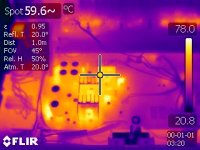 IR_1311.jpg174.8 KB · Views: 203
IR_1311.jpg174.8 KB · Views: 203 -
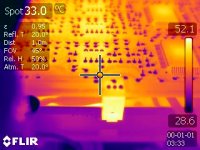 IR_1327.jpg176.6 KB · Views: 90
IR_1327.jpg176.6 KB · Views: 90 -
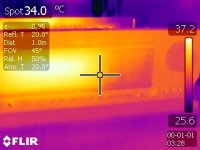 IR_1323.jpg170.3 KB · Views: 88
IR_1323.jpg170.3 KB · Views: 88 -
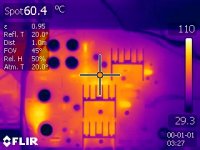 IR_1322.jpg173.6 KB · Views: 84
IR_1322.jpg173.6 KB · Views: 84 -
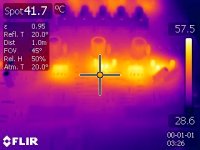 IR_1321.jpg171 KB · Views: 91
IR_1321.jpg171 KB · Views: 91 -
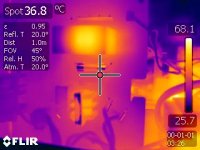 IR_1319.jpg172.8 KB · Views: 85
IR_1319.jpg172.8 KB · Views: 85 -
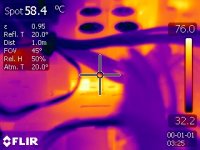 IR_1318.jpg173.3 KB · Views: 178
IR_1318.jpg173.3 KB · Views: 178 -
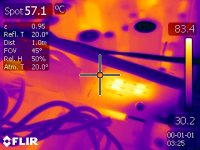 IR_1317.jpg175.2 KB · Views: 187
IR_1317.jpg175.2 KB · Views: 187 -
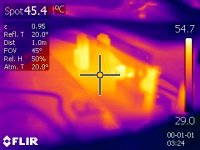 IR_1316.jpg171.6 KB · Views: 187
IR_1316.jpg171.6 KB · Views: 187 -
 IR_1312.jpg172.6 KB · Views: 190
IR_1312.jpg172.6 KB · Views: 190
Well I maxed out the uploads...
The more I look at this, the more I am leaning towards the Relays been faulty theory of mine as a quick look at the schematics reveals two Realis are right in, yep you guessed it, the signal path. In my books this is an absolute no go for HiFi equipment of such kind, BIG Thanks SONY ! WTF where they thinking ?
So if I had to put money on it, it be the RY804 and RY805. I bet that the coil keeps these nice and warm all the time, just right to help oxidization of the contacts.... Since I highly doubt SONY installed upper end relays with precious metal contacts in there...
The more I look at this, the more I am leaning towards the Relays been faulty theory of mine as a quick look at the schematics reveals two Realis are right in, yep you guessed it, the signal path. In my books this is an absolute no go for HiFi equipment of such kind, BIG Thanks SONY ! WTF where they thinking ?
So if I had to put money on it, it be the RY804 and RY805. I bet that the coil keeps these nice and warm all the time, just right to help oxidization of the contacts.... Since I highly doubt SONY installed upper end relays with precious metal contacts in there...
Attachments
I would check selector switch contacts and the many dry joints.
Sony, Hitachi, Onkyo, Grundig, Sanyo, Yamaha, B&O, Technics (high end only), Marantz and countless other manufacturers use relays in the signal line. Is kct saying they are all bad design and problematic?
Sony, Hitachi, Onkyo, Grundig, Sanyo, Yamaha, B&O, Technics (high end only), Marantz and countless other manufacturers use relays in the signal line. Is kct saying they are all bad design and problematic?
Please check the output relay in the power amp too. Sony is famous for using gold plated contact relays in their older amps there and they go bad very often as gold plated contacts are totally unusable for switching current. I even stock replacement relays for Sony amps as it is standard practice. I haven't seen the amps you own so please be aware that this is suspicion/assumption based on experience with various other Sony amps. I use Schrack silver contact relays for amplifier outputs. You could replace the signal relays too for known good ones with gold plated contacts like those from Takamisawa etc.
Sony also has a habit of not using heatsinks on driver transistors letting them cook. When they are overheated for a long time then they will also crackle. I found with many of them that the transistors had become too hot for too long which results in PCB tracks peeling off when replacing the faulty transistors. You have been warned 😉 If you replace them be sure to add a heatsink, they need one. The pictures of kct show clearly that some transistors are quite hot and although they can take this for years they will eventually fail. Be very careful with soldering and make sure to screw the heatsink to the transistor beforehand. Then solder/mount the transistor right straight away as bending them so that they're mounted right afterwards is enough to peel their PCB tracks off the board!
It shouldn't come as a surprise that electrolytic caps often go bad too if they had a hot neighbor (transistor) for years. Sorry to tell you but often renovating these old amplifiers is a risky and costly affair. For this reason I do this preventive so before problems occur (of course only with known problems of that specific series). This is not a waste of money as it prevents damage etc.
Sony also has a habit of not using heatsinks on driver transistors letting them cook. When they are overheated for a long time then they will also crackle. I found with many of them that the transistors had become too hot for too long which results in PCB tracks peeling off when replacing the faulty transistors. You have been warned 😉 If you replace them be sure to add a heatsink, they need one. The pictures of kct show clearly that some transistors are quite hot and although they can take this for years they will eventually fail. Be very careful with soldering and make sure to screw the heatsink to the transistor beforehand. Then solder/mount the transistor right straight away as bending them so that they're mounted right afterwards is enough to peel their PCB tracks off the board!
It shouldn't come as a surprise that electrolytic caps often go bad too if they had a hot neighbor (transistor) for years. Sorry to tell you but often renovating these old amplifiers is a risky and costly affair. For this reason I do this preventive so before problems occur (of course only with known problems of that specific series). This is not a waste of money as it prevents damage etc.
Last edited:
Thank you all for your kind words of wisdom.
I'm in the middle of moving house at the moment so will investigate further when I have the time.
There are indeed many gold plated items within the amplifier so the relay is quite a good candidate but so are the other components as indicated.
I am really hoping it is not any of the transistors as if I replace them I am very concerned that I would lose the classic Sony sound. I was also thinking of replacing all of the resistors with wirewound types but I am unsure of how much this would benefit the system and reduce the white noise.
Again thank you all very much for your help! I love this equipment so much and it is good to know there are many others out there who willing to share their experience
I'm in the middle of moving house at the moment so will investigate further when I have the time.
There are indeed many gold plated items within the amplifier so the relay is quite a good candidate but so are the other components as indicated.
I am really hoping it is not any of the transistors as if I replace them I am very concerned that I would lose the classic Sony sound. I was also thinking of replacing all of the resistors with wirewound types but I am unsure of how much this would benefit the system and reduce the white noise.
Again thank you all very much for your help! I love this equipment so much and it is good to know there are many others out there who willing to share their experience
Wirewound = bad choice except for low inductance types in the power stage but why would you ? The ones in the output stage seldom fail. Focus on the general state of all parts to determine what is defective and work very careful not to damage the boards. You now have the typical Sony crackling sound, first solve that and don't worry about the character of the amp 😉 If you really like the amp in defective state you will like it even more when it is fixed. I would replace all caps for Panasonic FC, resistors for higher rated metal film ones (if they look like on the picture) and the transistors for new ones with heatsinks. Did it with many old Sony amps and they always came out nice of the "make over". Doing all at once may seem excessive but after many hours of fault finding this method turned out to cost the least in time and the amp is fresh again with all connections resoldered and a more or less guaranteed result. It its only worthwhile if you keep it as resale value will not be better.
Last edited:
- Status
- Not open for further replies.
- Home
- Amplifiers
- Solid State
- Crackling Sony TA-2000F Pre and TA-3200F Power
